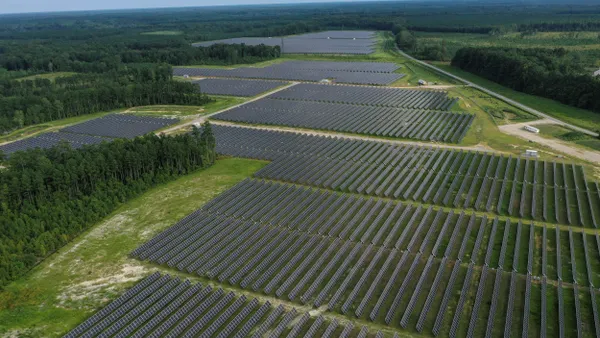Dive Brief:
-
Audi has joined the ranks of auto makers entering the market for energy storage with a pilot project in the Ingolstadt area of Germany and the Zurich region of Switzerland.
-
The pilot project will combine rooftop solar panels, stationary energy storage and electric vehicle charging stations that together can provide grid balancing services and in aggregate can operate as a virtual power plant.
-
Audi's announcement was quickly followed by Nissan's announcement of a program that offers U.K. customers an integrated package that includes solar panels and a battery storage system designed to maximize the use of renewable energy for charging an electric vehicle.
Dive Insight:
The automakers' efforts share several common concerns. They are looking to extend the life of batteries that are no longer useful in an electric vehicle but have enough juice left to store power for a household or provide residential backup power. They are working toward energy systems that allow for a more sustainable energy ecosystem for electric vehicles. And, by increasing the market for batteries, they hope to improve the economies of scale of battery manufacturing and drive down costs.
Audi, for instance, said its recent announcement will help it move closer to providing "emission-free premium mobility." That could also be a strong selling point among customers looking to purchase an electric vehicle as an EV is only as green as the network that provides the power to charge it.
Overall, most auto makers' participation in the stationary storage market takes the form of pilot projects. There are exceptions, such as Tesla, which has a separate energy storage division, but most auto makers are trying to find ways to generate more revenue through electric vehicles, or make those revenue streams available to their customers, Chris Robinson, an energy storage analyst at Lux Research, told Utility Dive. In most of the pilot projects, the manufacturers "are trying to find a way to make EVs more affordable," he said.
Recent announcements by Audi and Nissan follow earlier plans unveiled by Tesla, BMW and Mercedes Benz. Tesla, in April 2015, became the first auto maker to enter the energy storage market with the introduction of its Powerwall system. Last May, Tesla said it would combine Powerwall installations with its commercial scale Powerpack batteries as a way of aggregating storage capability and make it more useful for balancing the grid.
In June 2016, BMW said it was entering the market for home storage by making its i3 high lithium-ion batteries available to households. The car maker said it could potentially expand the program to include its re-purposed 2nd Life Batteries, as they become available in the market. The systems can be used to store power from a rooftop solar system or they can be used as a source of backup energy for a home charging station for electric vehicles.
BMW's plans followed a November 2016 announcement by Daimler, parent company or Mercedes-Benz, that it was starting a U.S. stationary energy storage unit, Mercedes-Benz Energy Americas, to tap into the North American energy storage market.
Mercedes' residential battery would allow customers to smooth peak energy consumption, integrate distributed solar energy and access backup power during outages.
And French auto maker Renault last October created a subsidiary to create smart charging networks, explore vehicle-to-grid solutions and utilize second-life EV batteries for stationary energy storage projects.













